By Lim Kim Keang with contributions from Lim Kim Chuah and Yong Ding Li. Photos from Ria Tan and Alan OwYong.
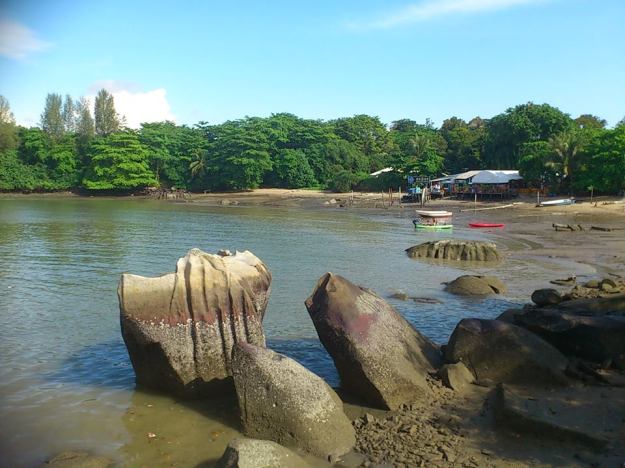
Pulau Ubin, the wild rustic corner of Singapore, view from the Jetty. Photo: Ria Tan.
INTRODUCTION
On 5 June 2016, the Nature Society (Singapore) Bird Group conducted a survey to find out which were the commonest bird species on Pulau Ubin. This survey was organized in conjunction with the month-long Pesta Ubin 2016 event. The Bird Group has been birding on Pulau Ubin since the 1970’s and 80’s and this survey to determine the commonest bird species on Pulau Ubin was also timely.
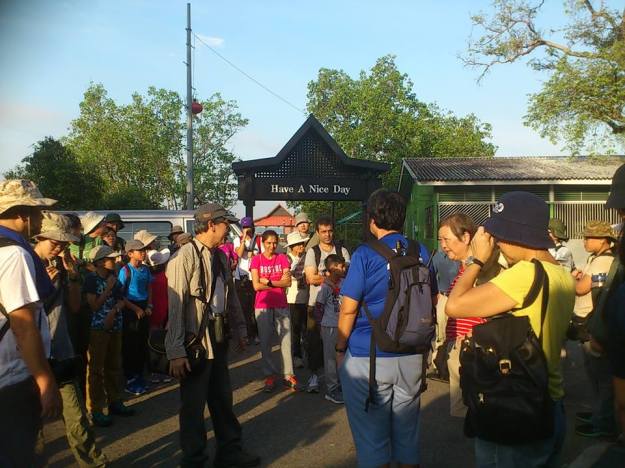
Willie Foo welcoming bird watchers to Ubin at the start of Pesta Ubin 2016 Commonest Bird Quest. Photo: Ria Tan
METHOD
A total of six teams consisting of six leaders and six participants took part in the CBQ. Areas in the central and eastern part of Pulau Ubin were covered. The routes were carefully selected to cover as much of the island as possible within the allocated time from 8.00 to 10.00 am. The good weather helped and most teams completed their designated route in the allocated time except two which went on overtime.
The MacKinnon bird listing method was used to determine the commonest birds on Pulau Ubin. This method involved recording each new species of birds (seen or heard) until a pre-defined number of species is reached. Once this pre-defined number is reached, a new list is started. Any one species will only be recorded once in the first list but may be recorded again in subsequent lists. For our purpose, we decided counting up to 10 species before starting on a new list.
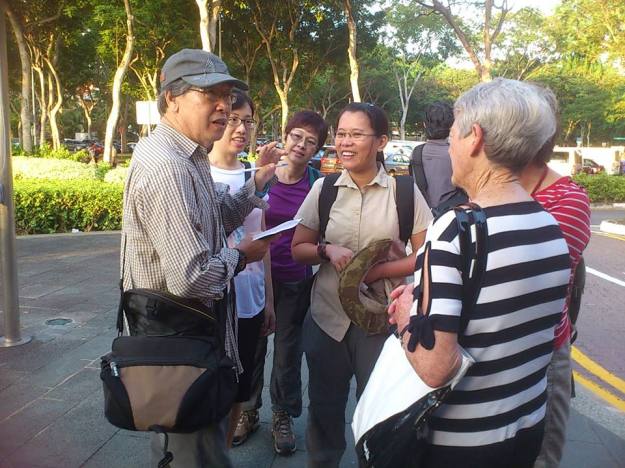
Willie Foo, Secretary of the Bird Group, briefing the team on how to record the birds based on the Mackinnon Bird Listing Method. Photo: Ria Tan
The relative abundance of each species is calculated by dividing the number of contacts by the maximum total number of contacts by all teams (i.e. total number of lists). A bird which is more common will have a higher relative abundance index than one which is less common.
RESULTS & DISCUSSION
Table 1 shows the top 20 commonest birds based on the relative abundance indices.
Table 1: Top 20 species of Birds of the Pesta Ubin 2016 Commonest Bird Quest
| Rank | Common Name | Total Contacts | Rel. Abund. Index | Rank | Common Name | Total Contacts | Rel. Abund Index |
| 1 | Olive-winged Bulbul | 33 | 0.65 | 11 | Straw-headed Bulbul | 17 | 0.33 |
| 2 | Common Iora | 27 | 0.53 | 12 | Red Jungle Fowl | 17 | 0.33 |
| 3 | Oriental Magpie Robin | 24 | 0.47 | 13 | Pink-necked Green Pigeon | 17 | 0.33 |
| 4 | White-rumped Shama | 24 | 0.47 | 14 | Van Hasselt’s Sunbird | 16 | 0.31 |
| 5 | Brown-throated Sunbird | 23 | 0.45 | 15 | Yellow-vented Bulbul | 15 | 0.29 |
| 6 | Swiftlets | 22 | 0.43 | 16 | Oriental Pied Hornbill | 15 | 0.29 |
| 7 | Javan Myna | 21 | 0.41 | 17 | Common Tailorbird | 15 | 0.29 |
| 8 | Collared Kingfisher | 20 | 0.39 | 18 | Crimson Sunbird | 14 | 0.27 |
| 9 | Olive-backed Sunbird | 18 | 0.35 | 19 | Asian Glossy Starling | 12 | 0.24 |
| 10 | Dark-necked Tailorbird | 18 | 0.35 | 20 | Ashy Tailorbird | 11 | 0.22 |
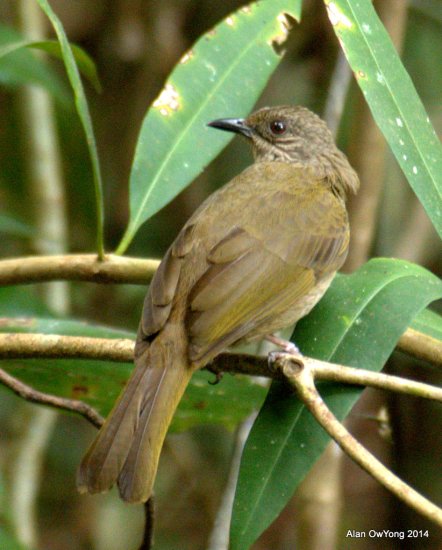
Olive-winged Bulbul is Ubin’s most abundant species.
The survey by the six teams produced a total of 51 lists. The relative abundance index of the birds detected ranged from 0.02 to 0.65. A total of 63 species were recorded during the CBQ. The most abundant species is the Olive-winged Bulbul. It recorded the highest relative abundance index of 0.65 and was recorded in all the surveyed sites. This is interesting as other censuses conducted by the Bird Group have consistently found the Yellow-vented Bulbul to be the more common bird in most parts of Singapore. The habitat on Pulau Ubin which consists of a mosaic of orchards, old rubber plantations and secondary forest probably contributed to this result.
Another interesting point is that more species were recorded in the central routes than the eastern ones. It is possible that the more wooded nature and closed canopy along the eastern routes could have resulted in less birds been detected.
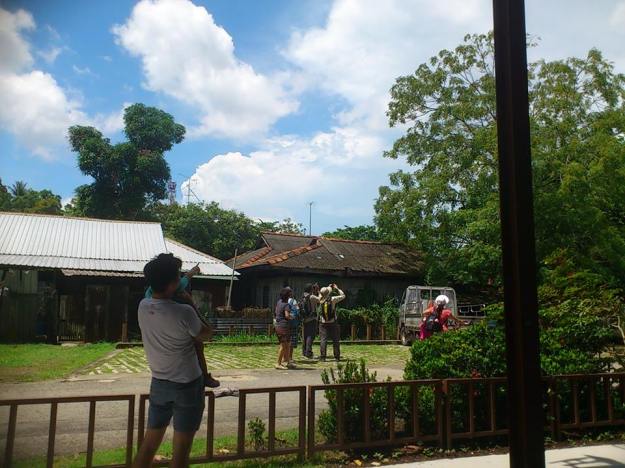
Six teams fanned out across Central and Eastern Ubin to try to find the commonest birds on the island. Photo: Ria Tan.
A very significant observation from the survey is the relative abundance of both the Straw-headed Bulbul and White-rumped Shama. Both species are becoming scarce in many parts of Southeast Asia as a result of rampant trapping for the bird trade. It is critical that the authorities and the public remain vigilant against potential poaching here and other parts of Singapore where these species are thriving. If the current situation persists, Singapore could become the only place in the world where these species survive in the wild.
As in all rapid survey and census, it is inevitable that biases exist. The most obvious bias is that this is a rapid one day count lasting only 2 to 2.5 hours. It is conducted at a time where some species may be more vocal than others and most if not all migrants are absent. Another issue involves the detection bias towards species that are more vocal or active at the edges of habitats as the selected routes were along existing roads, trails or boardwalks. But in general this survey does provide a fairly good picture of which are that common resident birds that you can expect to see on a bird walk on the island in the middle of the year.
Table 2: Summary of contacts(heard/sighted) and species of birds surveyed during the CBQ
| Site | W1 | CT1 | CT2 | CJ1 | CJ2 | CJ3 | Overall | ||
| Total In Top 20 Species List | 19 | 17 | 19 | 18 | 16 | 13 | 20 | ||
| Total species (heard/sighted) | 39 | 33 | 37 | 31 | 25 | 27 | 63 | ||
| Total contacts (heard/sighted) | 108 | 79 | 87 | 110 | 57 | 60 | 501 | ||
|
Legend |
|||||||||
| W1 | Siam Temple Route | ||||||||
| CT1 | Sensory Trail – Pekan Quarry Loop | ||||||||
| CT2 | Nordin Beach Route | ||||||||
| CJ1 | Chek Jawa Coastal Route | ||||||||
| CJ2 | Chek Jawa Balai Quarry Route | ||||||||
| CJ3 | Murai Hut – Mamam Beach Loop | ||||||||
COMMENTS
The Pesta Ubin Commonest Birds Quest provided an opportunity to involve and encourage the public to participate in a citizen science project. The data collected over an extended duration could be used to monitor changes to the avifauna of Pulau Ubin and ultimately the state of the environment here. A common bird today may become very rare or even become extinct tomorrow if its habitat is altered irreversibly or destroyed. One example is the House Swift which is no longer a common species. House Swifts used to build nests under the Pulau Ubin Jetty but have been absent for many years. Are the proliferation of swiftlet houses and the hordes of swiftlets the cause of decline? Or are there more serious environmental problems?
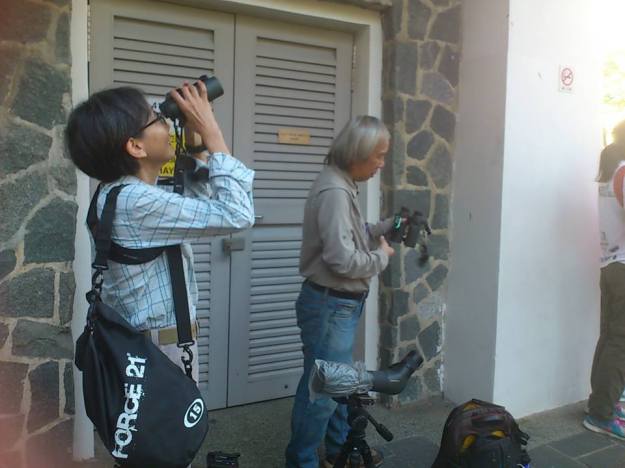
NSS Bird Group’s Lee Ee Ling and Lim Kim Keang the organisers for the Pesta Ubin 2016 Commonest Bird Quest. Photo: Ria Tan.
ACKNOWLEDGEMENT
We would like to thank the leaders, participants and organizers of Pesta Ubin especially Ria Tan. The Pesta Ubin CBQ 2016 participants were: Andrew Chow, Doreen Ang, Joseph Chan, Lee Ee Ling, Lim Kim Chuah, Lim Kim Keang, Loh Wang Chiu, Ng Chay Tuan, Peng Ah Huay, Rob, Willie Foo, Rob Arnold and Yong Yik Shih.
REFERENCE
MacKinnon J. (1993), A field guide to the Birds of Borneo, Sumatra, Java and Bali. Oxford University Press.

Impressed with your blog……..headed there for 6 days to photograph birds in November. I will read carefully so I can work out where to go. Many thanks, I am sure this will only be the first of a number of trips.
LikeLike
Hi Robert. Hope the blog will help you to get your target birds in Ubin. The island is still one of our better bird spots with high diversity and some surprises. Thanks for the kinds comments.
LikeLike